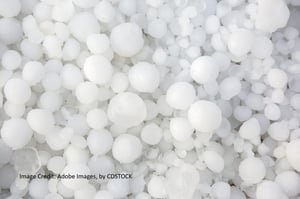In a previous post, we talked about how to inspect your roof after a hailstorm and recognize some signs of hail damage to roofs. This is crucial for a safe, secure roof: Texas is one of the country’s leaders in hail-related insurance claims – and Travis, Hays and Williamson Counties are some of the state’s most active areas when it comes to hail!
Our series on hail continues today with more advice on dealing with hail damage.
How Hail Damage Affects Older Shingles
Roofing manufacturers often claim that their shingle roofing systems will be good for 30 years, but this is rarely the case in practice. Most Austin shingle roofs last about 20 years when weather  damage is factored in. Hail damage to shingles is one of the biggest things that can age a roof prematurely.
damage is factored in. Hail damage to shingles is one of the biggest things that can age a roof prematurely.
Older roofs are at particular risk. When roofs have softened over time, it means a single large hailstone may be able to punch through a shingle. Deterioration of the waterproof membrane beneath shingles accelerates the emergence of leaks, since the underlayment can no longer prevent water intrusion.
Some of the top indicators of hail damage include:
1. Bruising
Bruising disperses the reflective granules on the shingle’s surface, leading to an indentation. They are not always visible, but you may notice large pockets of granules in your gutter or scattered around the ground.
2. Missing or Loose Granules
Granules can also be lost as a result of wind damage. A missing stripe of granules 1-2 inches below the next shingle above may indicate that the shingle was loose and flapping during the storm’s wind gusts.
3. Cracking
Hail strikes from bigger stones can create large cracks in circular patterns. This is the form of hail damage to shingles that’s most likely to lead to roof leaks later on, as the shingle loses its waterproof qualities.
After a hailstorm that causes visible damage, you’re certain to need a roof inspection from a local roofing professional. This is because your insurance company will insist on establishing that the damage is really caused by hail and not by gradual deterioration of roof structures over time – old age.
This can be contentious, since insurance companies want to pay out as little money as possible. In our next post, we’ll discuss the hail and age damage and how a roofing professional can tell the difference.
For immediate help or advice, contact Longhorn Roofing.


